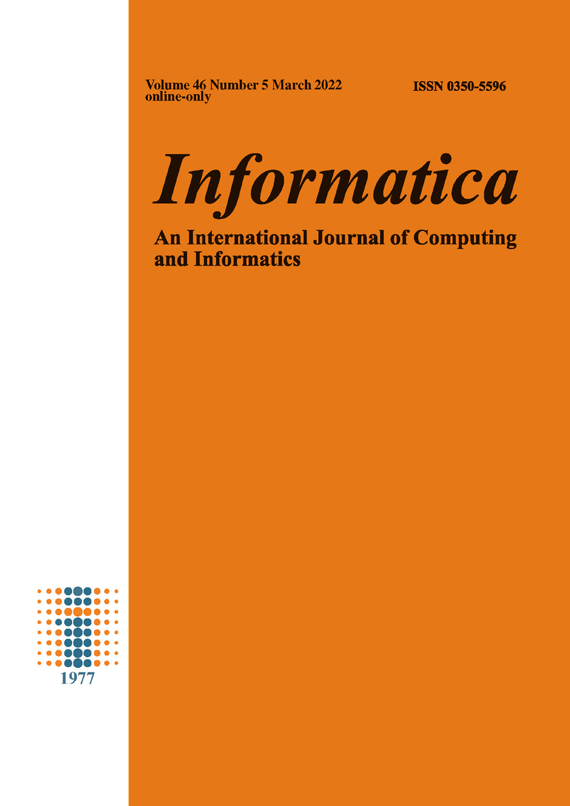Evaluating employee performance with an improved clustering algorithm
DOI:
https://doi.org/10.31449/inf.v46i5.4079Abstract
This paper introduced performance appraisal management, analyzed its principles, proposes seven appraisal indicators, put forward an improved K-means algorithm for the classification of appraisal results based on the K-means clustering algorithm and density parameters, and analyzed the performance of the method. The results of the UCI data set showed that the accuracy rate of the improved K-means algorithm was significantly higher than that of the traditional K-means algorithm, and its highest accuracy rate was 91.27%. The classification of the appraisal results of 45 employees in Company A showed that the classification results obtained using the improved K-means algorithm were more in line with the actual situation and more reasonable and relevant than the traditional scoring method. The appraisal results of 1064 technical employees showed that most of the employees had a good performance. The results of the experiment verify the effectiveness of the improved K-means algorithm in performance appraisal management. The algorithm can be further promoted and applied in practice.
References
Moradi T, Mehraban M A, Moeini M (2017). Comparison of the Perceptions of Managers and Nursing Staff Toward Performance Appraisal. Iranian journal of nursing and midwifery research, 22, pp. 128.
Gomez-Mejia LR (2016). Increasing Productivity: Performance Appraisal and Reward Systems. Personnel Review, 2016, 19, pp. 21-26. https://doi.org/10.1108/00483489010138759
Yousif M K, Shaout A (2016). Fuzzy logic computational model for performance evaluation of Sudanese Universities and academic staff. Journal of King Saud University - Computer and Information Sciences, 30, pp. 80-119. https://doi.org/0.1016/j.jksuci.2016.08.002
Ditzian K, Wilder D A, King A, Tanz J (2015). An evaluation of the Performance Diagnostic Checklist-Human Services to assess an employee performance problem in a center-based autism treatment facility. Journal of Applied Behavior Analysis, 48, pp. 199. https://doi.org/10.1002/jaba.171
Bird H (2015). Appraising clever people: lessons from introducing performance reviews for academics in a UK University. Industrial & Commercial Training, 47, pp. 81-85. https://doi.org/10.1108/ICT-10-2014-0069
Karpenko A, Karpenko N, Shudrik O (2020). Development and implementation of a strategic personnel management system according to goals based on key performance indicators. Management and Entrepreneurship Trends of Development, 2, pp. 22-35. https://doi.org/10.26661/2522-1566/2020-2/12-02
Uysal G (2016). Cognitive Placement Theory for Performance Appraisal: Talent Management and Individual Performance. Journal of Modern Accounting and Auditing , 012, pp. 60-63. https://doi.org/10.17265/1548-6583/2016.01.005
Nair M S, Salleh R (2015). Linking Performance Appraisal Justice, Trust, and Employee Engagement: A Conceptual Framework. Procedia - Social and Behavioral Sciences, 211, pp. 1155-1162. https://doi.org/10.1016/j.sbspro.2015.11.154
Andersson G (2016). Data Recording in Performance Management: Trouble With the Logics. American Journal of Evaluation, 38, pp. 190-204. https://doi.org/10.1177/1098214016681510
Lonsdale A (2016). Performance Appraisal, Performance Management and Quality in Higher Education: Contradictions, Issues and Guiding Principles for the Future. Australian Journal of Education, 42, pp. 303-320. https://doi.org/10.1177/000494419804200307
Lv Y, Ma T, Tang M, Cao J, Tian Y, Al-Dhelaan A, Al-Rodhaan M (2016). An efficient and scalable density-based clustering algorithm for datasets with complex structures. Neurocomputing, 171, pp. 9-22. https://doi.org/10.1016/j.neucom.2015.05.109
Guo Y, Sengur A (2015). NCM: Neutrosophic c-means clustering algorithm. Pattern Recognition, 48, pp. 2710-2724. https://doi.org/10.1016/j.patcog.2015.02.018
Dhanachandra N, Manglem K, Chanu Y J (2015). Image Segmentation Using K -means Clustering Algorithm and Subtractive Clustering Algorithm. Procedia Computer Science, 54, pp. 764-771.
Zhang Y, Zhang P (2015). Machine training and parameter settings with social emotional optimization algorithm for support vector machine. Pattern Recognition Letters, 54, pp. 36-42. https://doi.org/10.1016/j.patrec.2014.11.011
Downloads
Published
Issue
Section
License
I assign to Informatica, An International Journal of Computing and Informatics ("Journal") the copyright in the manuscript identified above and any additional material (figures, tables, illustrations, software or other information intended for publication) submitted as part of or as a supplement to the manuscript ("Paper") in all forms and media throughout the world, in all languages, for the full term of copyright, effective when and if the article is accepted for publication. This transfer includes the right to reproduce and/or to distribute the Paper to other journals or digital libraries in electronic and online forms and systems.
I understand that I retain the rights to use the pre-prints, off-prints, accepted manuscript and published journal Paper for personal use, scholarly purposes and internal institutional use.
In certain cases, I can ask for retaining the publishing rights of the Paper. The Journal can permit or deny the request for publishing rights, to which I fully agree.
I declare that the submitted Paper is original, has been written by the stated authors and has not been published elsewhere nor is currently being considered for publication by any other journal and will not be submitted for such review while under review by this Journal. The Paper contains no material that violates proprietary rights of any other person or entity. I have obtained written permission from copyright owners for any excerpts from copyrighted works that are included and have credited the sources in my article. I have informed the co-author(s) of the terms of this publishing agreement.
Copyright © Slovenian Society Informatika








